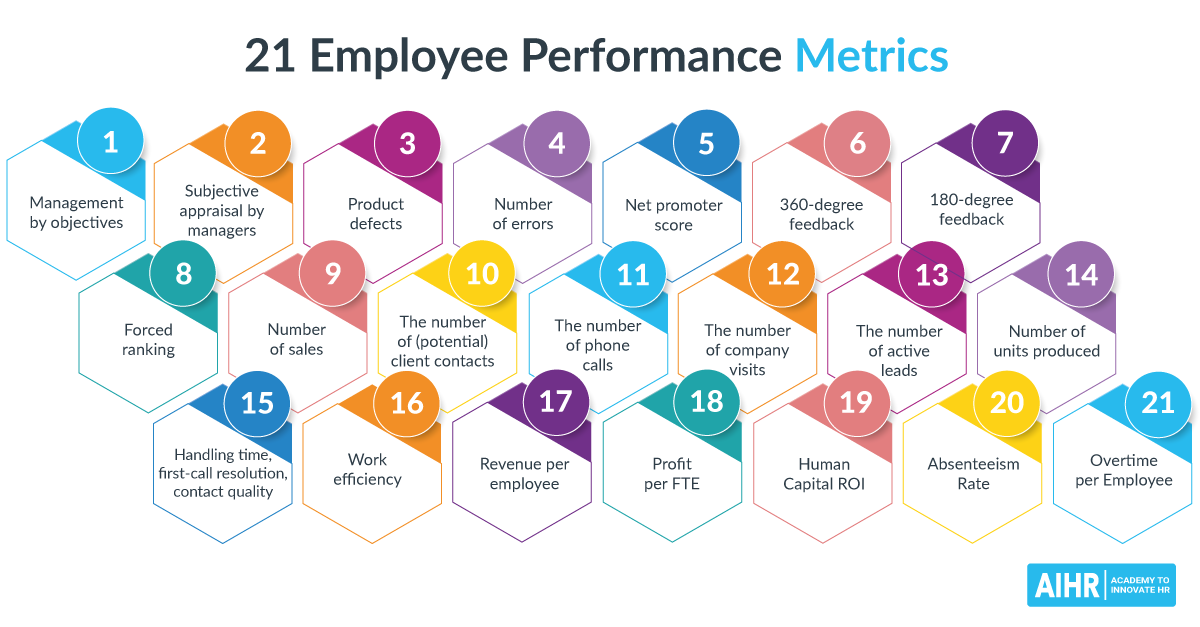
Employee performance metrics are crucial for tracking the effectiveness of employees in their roles. HR departments need reliable methods to measure productivity and efficiency. By monitoring employee performance metrics, organizations can benefit both the business and the employees themselves. In this article, we will discuss 21 key performance indicators (KPIs) for employees, along with examples of each.
Work Quality Employee Performance Metrics
-
Management by Objectives: The management by objectives approach involves setting specific individual goals for employees that align with organizational objectives. These goals are reviewed and progress is tracked to ensure performance improvement.
-
Subjective Appraisal by Manager: Performance reviews conducted by managers help assess employees based on various criteria, including the quality of their work. The 9-box grid is a useful tool for visualizing performance and potential to guide talent management decisions.
-
Product Defects: In traditional manufacturing industries, tracking the number of product defects per employee or team is a common way to measure work quality. Minimizing defects is essential for maintaining high-quality output.
-
Number of Errors: For industries like software development, measuring the number of errors per thousand lines of code is an effective metric. This ensures the production of high-quality code and reduces the risk of software malfunctions.
-
Net Promoter Score: Net promoter score (NPS) indicates the willingness of customers to recommend a company’s service to others. This metric can be used to assess the performance of sales employees and their ability to satisfy customers.
-
360-Degree Feedback: This method involves gathering feedback from peers, subordinates, customers, and managers to provide a comprehensive assessment of an employee’s performance. It offers a multi-perspective view of an employee’s strengths and areas for improvement.
-
180-Degree Feedback: A simplified version of 360-degree feedback, in which only the employee’s colleagues and direct manager provide feedback. This approach is suitable for employees who do not have direct customer contact or managerial responsibilities.
-
Forced Ranking: Also known as the vitality curve, forced ranking involves ranking employees from best to worst based on their performance. This allows organizations to identify top performers and facilitate succession planning.
Work Quantity Employee Performance Metrics
-
Number of Sales: This straightforward metric is commonly used to evaluate the performance of sales employees. However, it may be less reliable for complex sales cycles, where other metrics are more suitable.
-
Number of (Potential) Client Contacts: The number of contacts an employee has with clients, such as phone calls and company visits, can indicate their ability to generate leads and build relationships.
-
Number of Active Leads: Tracking the number of active leads an employee is managing can provide insights into their effectiveness in driving sales.
-
Number of Units Produced: This metric is applicable to industries involved in manufacturing or data entry. It quantifies the output by measuring the number of units or keystrokes per minute.
-
Handling Time and First-Call Resolution: Contact centers rely on metrics such as average handling time and first-call resolution to evaluate the performance of customer service representatives. These indicators reflect the efficiency and quality of customer interactions.
-
Contact Quality: Assessing the quality of customer interactions is crucial for delivering exceptional service. This metric allows organizations to measure employee performance in terms of customer satisfaction.
Work Efficiency Employee Performance Metrics
- Work Efficiency: Work efficiency measures the balance between quantity and quality, taking into account the resources required to achieve a specific output. Achieving this balance can be challenging, but it is essential for optimizing performance and productivity.
Organization Level Employee Performance Metrics
-
Revenue per Employee: This metric calculates the revenue generated per full-time equivalent (FTE) employee. It provides a rough estimate of an employee’s contribution to the organization’s overall revenue.
-
Profit per Employee: Similar to revenue per employee, profit per employee measures the profitability generated by each FTE. This metric reflects the financial health of the organization.
-
Human Capital ROI: Human capital ROI assesses the value of the knowledge, skills, and attributes of employees. It is calculated by dividing the company’s total revenue (minus operating expenses and compensation) by the total compensation and benefits cost.
-
Absenteeism Rate: Absenteeism is inversely related to performance, and high absenteeism rates can indicate lower organizational performance. Motivated and engaged employees tend to take fewer sick days, contributing to higher productivity.
-
Overtime per Employee: While overtime may initially seem like a way to motivate employees, excessive overtime can negatively impact performance and morale. Monitoring overtime per employee ensures a healthy work-life balance and promotes higher overall performance.
It is important to note that no single metric can fully capture employee performance. The best approach involves combining qualitative and quantitative metrics, such as subjective appraisals, sales numbers, and work efficiency indicators. Utilizing a mix of feedback from multiple sources provides a more comprehensive and accurate evaluation of employee performance.
To learn more about using metrics effectively in your organization, check out our Strategic HR Metrics course.
